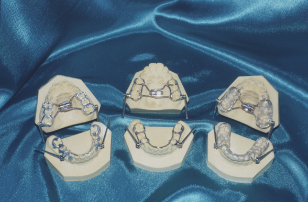35
Functional appliances
WHAT ARE FUNCTIONAL APPLIANCES?
Functional appliances are removable or fixed orthodontic appliances that aim to utilise, eliminate or guide the forces arising from muscle function, tooth eruption and growth in order to alter skeletal and dental relationships. This chapter will be limited to the use of functional appliances in the treatment of Class II malocclusions. Without such treatment, most Class II cases remain unchanged or deteriorate. For example, among untreated pre-pubertal children with Class II malocclusion taking part in a randomised controlled clinical trial, only about one-third showed an improved sagittal jaw base relationship, as assessed by annual change in ANB angle; the relationship was unchanged in about half and worsened in one out of six children.1
The term ‘functional appliance’ is so named, because it was initially believed that altering muscle function can cause a change in growth response. Devices such as the fixed inclined anterior bite plane, posterior inclined planes attached to bands cemented onto posterior teeth and the original fixed functional appliance (Herbst appliance, Figure 35.1)2 were described in a textbook 100 years ago.2 In 1902, the monobloc appliance was devised to posture the mandible forward in babies born with severely retrognathic mandibles that compromised their airway. In the 1920s, Andresen used the same principle of posturing the mandible forward to treat malocclusions with his activator appliance.3
INDICATIONS AND DESIGNS OF FUNCTIONAL APPLIANCES
There are various indications and designs of functional appliances. The most common indication is to correct Class II malocclusion by posturing the mandible forward in growing patients in an attempt to utilise the individual’s growth potential. The goal of this ‘growth modification’ is to change the anteroposterior occlusion between the upper and lower arches, and the procedure is often named the first-phase treatment. Because functional appliances cause some tilting of the teeth, part of the correction mediated by a functional appliance is actually attributable to this ‘orthodontic camouflage’, in addition to growth modification. If, after the first-phase treatment with a functional appliance, patients need further treatment to correct tooth irregularities and improve arch alignment, a second-phase treatment with a fixed appliance can be administered, with or without extractions. Some clinicians suggest that after the first phase of treatment there should be a period of retention with a functional appliance to consolidate the treatment results and stability. Finally, although functional appliances are primarily designed to treat Class II division 1 malocclusions, they can also be used to treat Class II division 2 malocclusions. Such treatment requires converting Class II division 2 incisor relationships to Class II division 1 relationships, to allow forward positioning of the mandible.
TIMING OF TREATMENT
Functional appliances should generally be used when patients are still growing so as to enhance the growth of the mandible. It has been suggested that treatment response is optimal during the pubertal growth spurt.4 Accordingly, standing height measurements, hand wrist radiographs, cervical vertebral maturation status and secondary sex characteristics have been advocated as tools to assess patients’ maturity status and if the pubertal growth spurt has happened yet or is in progress. Studies have also shown that favourable treatment outcomes can be achieved before and after the pubertal growth spurt. However, very early treatment may be followed by relapse, and treatment that starts too late may decrease the skeletal treatment response.
In general, it is considered better to start functional appliance therapy in the late mixed dentition or early permanent dentition, as doing so will allow patients to progress to the second-phase treatment with a fixed appliance. This approach will also require less adjustment of the removable functional appliance so as to allow tooth exfoliation and eruption of the permanent teeth. In contrast, fixed functional appliances, such as the Herbst appliance, are usually used in the permanent dentition because the splint is cemented to the teeth. The Herbst appliance is primarily used during adolescence, but it can also be used in adults and has been demonstrated to be a valid alternative to surgical advancement of the mandible in adults with moderate mandibular retrognathism.4 Nevertheless, early treatment with functional appliances to improve self-esteem is particularly important for patients who are being teased because their teeth are ‘sticking out’.
TYPES OF FUNCTIONAL APPLIANCE
There are multiple c/>
Stay updated, free dental videos. Join our Telegram channel

VIDEdental - Online dental courses



